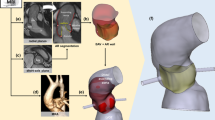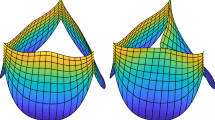Abstract
The congenital bicuspid aortic valve (BAV) is associated with increased leaflet calcification, ascending aortic dilatation, aortic stenosis (AS) and regurgitation (AR). Although underlying genetic factors have been primarily implicated for these complications, the altered mechanical environment of BAVs could potentially accelerate these pathologies. The objective of the current study is to characterize BAV hemodynamics in an in vitro system. Two BAV models of varying stenosis and jet eccentricity and a trileaflet AV (TAV) were constructed from excised porcine AVs. Particle Image Velocimetry (PIV) experiments were conducted at physiological flow and pressure conditions to characterize fluid velocity fields in the aorta and sinus regions, and ensemble averaged Reynolds shear stress and 2D turbulent kinetic energy were calculated for all models. The dynamics of the BAV and TAV models matched the characteristics of these valves which are observed clinically. The eccentric and stenotic BAV showed the strongest systolic jet (V = 4.2 m/s), which impinged on the aortic wall on the non-fused leaflet side, causing a strong vortex in the non-fused leaflet sinus. The magnitudes of TKE and Reynolds stresses in both BAV models were almost twice as large as comparable values for TAV, and these maximum values were primarily concentrated around the central jet through the valve orifice. The in vitro model described here enables detailed characterization of BAV flow characteristics, which is currently challenging in clinical practice. This model can prove to be useful in studying the effects of altered BAV geometry on fluid dynamics in the valve and ascending aorta. These altered flows can be potentially linked to increased calcific responses from the valve endothelium in stenotic and eccentric BAVs, independent of concomitant genetic factors.











Similar content being viewed by others
References
Aicher, D., et al. Endothelial nitric oxide synthase in bicuspid aortic valve disease. Ann. Thorac. Surg. 83(4):1290–1294, 2007.
Balachandran, K., et al. Elevated cyclic stretch alters matrix remodeling in aortic valve cusps: implications for degenerative aortic valve disease. Am. J. Physiol. Heart Circ. Physiol. 296(3):H756–H764, 2009.
Batchelor, G. K. An Introduction to Fluid Dynamics. Cambridge Mathematical Library: Cambridge, UK, 1967, p. 660.
Bauer, M., et al. Configuration of the ascending aorta in patients with bicuspid and tricuspid aortic valve disease undergoing aortic valve replacement with or without reduction aortoplasty. J. Heart Valve Dis. 15(5):594–600, 2006.
Bauer, M., et al. Different hemodynamic stress of the ascending aorta wall in patients with bicuspid and tricuspid aortic valve. J. Card. Surg. 21(3):218–220, 2006.
Bellhouse, B. J., and T. Talbot. The fluid mechanics of the aortic valve. J. Fluid Mech. 35(4):721–735, 1969.
Beppu, S., et al. Rapidity of progression of aortic stenosis in patients with congenital bicuspid aortic valves. Am. J. Cardiol. 71(4):322–327, 1993.
Bonow, R. O., et al. ACC/AHA 2006 guidelines for the management of patients with valvular heart disease: a report of the American College of Cardiology/American Heart Association Task Force on Practice Guidelines (writing committee to revise the 1998 Guidelines for the Management of Patients With Valvular Heart Disease): developed in collaboration with the Society of Cardiovascular Anesthesiologists: endorsed by the Society for Cardiovascular Angiography and Interventions and the Society of Thoracic Surgeons. Circulation 114(5):e84–e231, 2006.
Braverman, A. C., et al. The bicuspid aortic valve. Curr. Probl. Cardiol. 30(9):470–522, 2005.
Cotrufo, M., et al. Different patterns of extracellular matrix protein expression in the convexity and the concavity of the dilated aorta with bicuspid aortic valve: preliminary results. J. Thorac. Cardiovasc. Surg. 130(2):504–511, 2005.
Dasi, L. P., et al. Vorticity dynamics of a bileaflet mechanical heart valve in an axisymmetric aorta. Phys. Fluids 19(6):067105(1)–067109(17), 2007.
den Reijer, P. M., et al. Hemodynamic predictors of aortic dilatation in bicuspid aortic valve by velocity-encoded cardiovascular magnetic resonance. J. Cardiovasc. Magn. Reson. 12:4, 2010.
Garg, V., et al. Mutations in NOTCH1 cause aortic valve disease. Nature 437(7056):270–274, 2005.
Giersiepen, M., et al. Estimation of shear stress-related blood damage in heart valve prostheses—in vitro comparison of 25 aortic valves. Int. J. Artif. Organs 13(5):300–306, 1990.
Girdauskas, E., et al. Is aortopathy in bicuspid aortic valve disease a congenital defect or a result of abnormal hemodynamics? A critical reappraisal of a one-sided argument. Eur. J. Cardiothorac. Surg. 39(6):809–814, 2011.
Goland, S., et al. Assessment of aortic stenosis by three-dimensional echocardiography: an accurate and novel approach. Heart 93(7):801–807, 2007.
Hope, T. A., et al. Comparison of flow patterns in ascending aortic aneurysms and volunteers using four-dimensional magnetic resonance velocity mapping. J. Magn. Reson. Imaging 26:1471–1479, 2007.
Hope, M. D., et al. Bicuspid aortic valve: four-dimensional MR evaluation of ascending aortic systolic flow patterns. Radiology 255(1):53–61, 2010.
Keane, R. D., and R. J. Adrian. Optimization of particle image velocimeters. I. Double pulsed systems. Meas. Sci. Technol. 1(11):1202–1215, 1990.
Keane, M. G., et al. Bicuspid aortic valves are associated with aortic dilatation out of proportion to coexistent valvular lesions. Circulation 102(19 Suppl 3):III35–III39, 2000.
Kline, S. J., and F. A. McClintock. Describing uncertainties in single-sample experiments. Mech. Eng. 75:3–8, 1953.
Leo, H. L., et al. Fluid dynamic assessment of three polymeric heart valves using particle image velocimetry. Ann. Biomed. Eng. 34(6):936–952, 2006.
Nistri, S., et al. Aortic root dilatation in young men with normally functioning bicuspid aortic valves. Heart 82(1):19–22, 1999.
Pachulski, R. T., A. L. Weinberg, and K. L. Chan. Aortic aneurysm in patients with functionally normal or minimally stenotic bicuspid aortic valve. Am. J. Cardiol. 67(8):781–782, 1991.
Peskin, C. S. Numerical analysis of blood flow in the heart. J. Comput. Phys. 25(3):220–252, 1977.
Pouleur, A. C., et al. Planimetric and continuity equation assessment of aortic valve area: Head to head comparison between cardiac magnetic resonance and echocardiography. J. Magn. Reson. Imaging 26(6):1436–1443, 2007.
Pouleur, A. C., et al. Aortic valve area assessment: multidetector CT compared with cine MR imaging and transthoracic and transesophageal echocardiography. Radiology 244(3):745–754, 2007.
Prasad, A. K., et al. Effect of resolution on the speed and accuracy of particle image velocimetry interrogation. Exp. Fluids 13(2–3):105–116, 1992.
Querzoli, G., S. Fortini, and A. Cenedese. Effect of the prosthetic mitral valve on vortex dynamics and turbulence of the left ventricular flow. Phys. Fluids 22:041901, 2010.
Roberts, W. C. The congenitally bicuspid aortic valve. A study of 85 autopsy cases. Am. J. Cardiol. 26(1):72–83, 1970.
Roberts, W. C., and J. M. Ko. Frequency by decades of unicuspid, bicuspid, and tricuspid aortic valves in adults having isolated aortic valve replacement for aortic stenosis, with or without associated aortic regurgitation. Circulation 111(7):920–925, 2005.
Robicsek, F., et al. The congenitally bicuspid aortic valve: how does it function? Why does it fail? Ann. Thorac. Surg. 77(1):177–185, 2004.
Saikrishnan, N. Studies in wall turbulence using dual plane particle image velocimetry and direct numerical simulation data. In: Aerospace Engineering & Mechanics. Minneapolis, MN: University of Minnesota, 2010, p. 224.
Sievers, H. H., and C. Schmidtke. A classification system for the bicuspid aortic valve from 304 surgical specimens. J. Thorac. Cardiovasc. Surg. 133(5):1226–1233, 2007.
Sucosky, P., et al. Altered shear stress stimulates upregulation of endothelial VCAM-1 and ICAM-1 in a BMP-4- and TGF-beta1-dependent pathway. Arterioscler. Thromb. Vasc. Biol. 29(2):254–260, 2009.
Ward, C. Clinical significance of the bicuspid aortic valve. Heart 83(1):81–85, 2000.
Warnes, C. A., et al. ACC/AHA 2008 guidelines for the management of adults with congenital heart disease: a report of the American College of Cardiology/American Heart Association Task Force on Practice Guidelines (Writing Committee to Develop Guidelines on the Management of Adults With Congenital Heart Disease). Developed in Collaboration with the American Society of Echocardiography, Heart Rhythm Society, International Society for Adult Congenital Heart Disease, Society for Cardiovascular Angiography and Interventions, and Society of Thoracic Surgeons. J. Am. Coll. Cardiol. 52(23):e1–e121, 2008.
Weinberg, E. J., and M. R. Kaazempur Mofrad. A multiscale computational comparison of the bicuspid and tricuspid aortic valves in relation to calcific aortic stenosis. J. Biomech. 41(16):3482–3487, 2008.
Xing, Y., et al. Cyclic pressure affects the biological properties of porcine aortic valve leaflets in a magnitude and frequency dependent manner. Ann. Biomed. Eng. 32(11):1461–1470, 2004.
Yap, C. H., et al. Experimental measurement of dynamic fluid shear stress on the aortic surface of the aortic valve leaflet. Biomech. Model. Mechanobiol. 11:171–182, 2011.
Yap, C. H., et al. Experimental technique of measuring dynamic fluid shear stress on the aortic surface of the aortic valve leaflet. J. Biomech. Eng. 133(6):15, 2011.
Yap, C. H., et al. Experimental measurement of dynamic fluid shear stress on the ventricular surface of the aortic valve leaflet. Biomech. Model. Mechanobiol. 11:231–244, 2011.
Acknowledgments
The authors would like to acknowledge Holifield Farms, Covington, GA and Town & Country Packing Company, Thomson, GA for providing porcine hearts. This study was funded by the American Heart Association Postdoctoral Fellowship Number 10POST3050054 and the Petit Undergraduate Research Scholars Program.
Author information
Authors and Affiliations
Corresponding author
Additional information
Associate Editor Jane Grande-Allen oversaw the review of this article.
Rights and permissions
About this article
Cite this article
Saikrishnan, N., Yap, CH., Milligan, N.C. et al. In Vitro Characterization of Bicuspid Aortic Valve Hemodynamics Using Particle Image Velocimetry. Ann Biomed Eng 40, 1760–1775 (2012). https://doi.org/10.1007/s10439-012-0527-2
Received:
Accepted:
Published:
Issue Date:
DOI: https://doi.org/10.1007/s10439-012-0527-2




